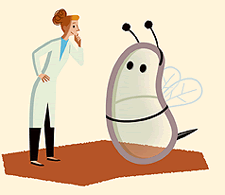Pioneering progress in spotting disease
New Fronts in the Effort to Conquer Cancer
![]() hen
some of the world’s best oncologists decided to collaborate on
cancer research and treatment they chose to include the University of
Miami. The basic and clinical research being conducted at UM/Sylvester
Comprehensive Cancer Center has led to new ways to discover and treat
cancers.
hen
some of the world’s best oncologists decided to collaborate on
cancer research and treatment they chose to include the University of
Miami. The basic and clinical research being conducted at UM/Sylvester
Comprehensive Cancer Center has led to new ways to discover and treat
cancers.
For patients in South Florida—as well as those across the United
States and around the world—it means better access to everything
from the latest experimental therapies to new lifesaving standards of
care.
Cooperating on Cancer
![]() he
adage says great minds think alike. Assuming that’s true, UM’s
oncologists find themselves in very good company.
he
adage says great minds think alike. Assuming that’s true, UM’s
oncologists find themselves in very good company.
The University of Miami/Sylvester Comprehensive Cancer Center has been named a main member institution of the Eastern Cooperative Oncology Group (ECOG), a branch of the National Cancer Institute at the National Institutes of Health. ECOG was established in 1955 but still has just 24 main members, all cancer research leaders, including Johns Hopkins University, the Mayo Clinic, Fox Chase Cancer Center, and Case Western Reserve University. UM is the only main member institution in Florida.
“The value to our patients is very clear,” says W. Jarrard Goodwin, M.D., F.A.C.S., director of UM/Sylvester. “They will benefit from access to more novel clinical trials from around the nation, and patients at other centers will have better access to our most promising homegrown research.”
ECOG is one of the largest clinical cancer research organizations in the nation, with almost 6,000 physicians, nurses, pharmacists, statisticians, and clinical research associates from the United States, Canada, and South Africa.
“This is something we’ve been pursuing for a while,” says Caio Max S. Rocha Lima, M.D., associate professor of medicine, hematology oncology, and principal investigator for ECOG.
“This presents us with more collaborative opportunities, and most importantly our patients are now going to have access in Florida to a higher number of novel and exciting new cancer treatments through clinical trials.”
Writing the Book on Bladder Cancer
![]() eaders
at the World Health Organization (WHO) and the world’s leading
urological society knew there was a wealth of new knowledge about bladder
cancer. They needed a way to share that information with as many health
care providers as possible, especially in rural and Third World regions.
eaders
at the World Health Organization (WHO) and the world’s leading
urological society knew there was a wealth of new knowledge about bladder
cancer. They needed a way to share that information with as many health
care providers as possible, especially in rural and Third World regions.
 “I got a call from the head of this consultation through the WHO,” says
Mark S. Soloway, M.D., chairman of the Miller School’s Department
of Urology. “He asked if I would like to chair this consultation.
The goal was to set up guidelines for bladder cancer, and that’s
all the guidance I was given. Then it was my job.”
“I got a call from the head of this consultation through the WHO,” says
Mark S. Soloway, M.D., chairman of the Miller School’s Department
of Urology. “He asked if I would like to chair this consultation.
The goal was to set up guidelines for bladder cancer, and that’s
all the guidance I was given. Then it was my job.”
Since then, the Société Internationale d’Urologie (SIU) has taken the administrative reins from the WHO, but it was still up to Soloway to get it done.
He divided bladder cancer into 11 disciplines, including epidemiology and diagnosis, molecular tumor markers, different tumor types and stages, urinary diversions, radiation therapy, chemotherapy, and non-traditional tumors. He selected chairpersons, including other UM faculty, then the committees went to work. They held three meetings over the period of a year, and then each group wrote one chapter for a book. It promises to become the world’s seminal text on the subject.
“This is really a major resource, with over 700 pages of reports related to bladder cancer,” says Soloway. “That’s why getting the best people together, with all their collective experience over many years with thousands of patients, was so important.”
The final product compiles the thoughts of more than 100 participants—world leaders in their disciplines, not just in urology but in oncology, radiology, epidemiology, and basic science.
“I truly feel that this text will be tremendously valuable to people around the world,” says Vinata B.
Lokeshwar, Ph.D., associate professor of urology and cell biology and anatomy at the Miller School. Lokeshwar chaired the committee on tumor markers, which yielded the longest chapter—a 157-page manuscript with 400 references.
Heartening News about Cancer
![]() ore
than 12 million Americans are currently taking cholesterol-lowering statins
to reduce theirrisk of cardiovascular disease. So how many of those
patients can expect to be diagnosed with prostate cancer?
ore
than 12 million Americans are currently taking cholesterol-lowering statins
to reduce theirrisk of cardiovascular disease. So how many of those
patients can expect to be diagnosed with prostate cancer?
 Almost none.
Almost none.
That’s the stunning finding of a retrospective study by Rakesh Singal, M.D., hematologist oncologist at UM/Sylvester and the Miami VA Medical Center, and his colleague Vikas Khurana, M.D., from the Louisiana State University Health Sciences Center.
“This is really quite remarkable,” says Singal. “A 90 percent reduction in prostate cancer risk in men using statins for four years or more and the fact that the risk is decreasing with duration of statin use.”
Singal and Khurana analyzed a database from ten Veterans Affairs medical centers in Louisiana, Mississippi, Texas, and Arkansas. They grouped 443,805 men by whether or not they took prescription statins to lower cholesterol and whether they were ever diagnosed with prostate cancer.
In the control group, prostate cancer—the most common cancer in the nation—appeared at a rate equivalent to the national average, but the men taking statins were much less likely to get the disease.
Double-Edged Sword
![]() nake
bites, spider bites, stings from scorpions and bees—they all have
something in common with cancer.
nake
bites, spider bites, stings from scorpions and bees—they all have
something in common with cancer.
Vinata B. Lokeshwar, Ph.D., associate professor of urology and cell biology and anatomy at the Miller School, has identified how the enzyme hyaluronidase, which is present in most venom, also plays a crucial role in the viability and spread of solid tumors.
Hyaluronidase breaks down hyaluronic acid (HA), a large, complex sugar polymer in human tissues. When hyaluronidase breaks down HA in tumors, the small fragments help cancer spread.
There have been two schools of thought on this enzyme. Researchers in California showed that treating tumors with hyaluronidase could inhibit tumor growth, but Lokeshwar showed that tumor cells produce hyaluronidase. In fact, she’s been using it as a diagnostic and prognostic marker for bladder and prostate carcinomas. So, among researchers, there was a spirited debate over whether the enzyme aided or impeded tumor growth.
Both sides were right.
Lokeshwar showed in a study published in Cancer Research that when cancer cells have between 42- and 80-milliunits of hyaluronidase, they actively grow and spread. Blocking the enzyme in bladder tumors cut tumor growth nine- to 17-fold.
 Adding more?
Adding more?
“The moment we exceeded that normal threshold there was no tumor—absolutely none,” says Lokeshwar. “The tumor just went away.” Block the enzyme and there isn’t enough for cancer to advance—add too much and it dies.
Promising New Cancer Test
![]() bout
eight out of ten oral, pharyngeal, and laryngeal cancers occur in people
who consume tobacco or alcohol, but not everybody who smokes and drinks
gets these head and neck cancers. They are hard to detect since there hasn’t
been a simple screening test.
bout
eight out of ten oral, pharyngeal, and laryngeal cancers occur in people
who consume tobacco or alcohol, but not everybody who smokes and drinks
gets these head and neck cancers. They are hard to detect since there hasn’t
been a simple screening test.
That could change soon.
“We’ve had a few patients where the CD44 test detected disease even though we weren’t able to see anything in the mouth,” says Elizabeth J. Franzmann, M.D., assistant professor of otolaryngology.
CD44 is a protein expressed—and shed—by squamous cell carcinomas, which account for almost all head and neck cancers. UM/Sylvester researchers had 26 head and neck cancer patients and ten healthy volunteers gargle saline, then they tested the result. They found saliva-soluble CD44 in 79 percent of the cancer patients but in none of the healthy volunteers, and the test worked whether the tumors were early or advanced.
The study was published in Cancer Epidemiology Biomarkers & Prevention. The technique is still being tested, but could become a screening test for people at risk. Catching the disease early can double the cure rate to more than 80 percent.